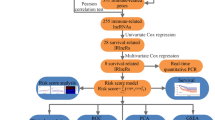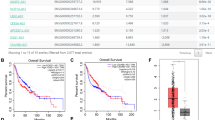Abstract
Purpose
In this study, whether HOTAIR is a prognostic biomarker will be detected, and its regulative effects of chemosensitivity to doxorubicin in TCC cells will be examined.
Methods
The expression of HOTAIR was detected by quantitative real-time PCR. Overall survival rate was calculated by Kaplan–Meier method with the log-rank test for comparisons. MTT assay was used to detect cell proliferation ability and chemosensitivity. Dual-color flow cytometric method was used to detect cell apoptosis.
Results
HOTAIR was up-regulated in bladder transitional cell carcinoma (TCC) tissues and cell lines compared with normal bladder transitional cell (NBTC) tissues and bladder epithelial immortalized SV-HUC-1 cells, and its expression level had positive correlation with histological grades of TCC. Moreover, HOTAIR was an independent prognostic biomarker of overall survival for TCC patients. The expression and silence vector for HOTAIR were transfected into T24 and J82 cells to up-regulate and silence the HOTAIR expression, respectively. In T24 and J82 cells, HOTAIR over-expression promoted cell proliferation and inhibited chemosensitivity to doxorubicin and cell apoptosis induced by doxorubicin; silence of HOTAIR showed opposite regulative effects.
Conclusions
In summary, lncRNA HOTAIR was an independent prognostic biomarker of overall survival in TCC patients and could regulate chemosensitivity to doxorubicin of human TCC cells. HOTAIR might provide a new potential therapeutic target and stratagem for TCC.



Similar content being viewed by others
References
Murta-Nascimento C, Schmitz-Dräger BJ, Zeegers MP, Steineck G, Kogevinas M, Real FX, Malats N (2007) Epidemiology of urinary bladder cancer: from tumor development to patient’s death. World J Urol 25:285–295
Hassen W, Droller MJ (2000) Current concepts in assessment and treatment of bladder cancer. Curr Opin Urol 10:291–299
Xu XD, Li KR, Li XM, Yao J, Qin J, Yan B (2014) Long non-coding RNAs: new players in ocular neovascularization. Mol Biol Rep 41(7):4493–4505
Zhao Y, Feng G, Wang Y, Yue Y, Zhao W (2014) Regulation of apoptosis by long non-coding RNA HIF1A-AS1 in VSMCs: implications for TAA pathogenesis. Int J Clin Exp Pathol 7(11):7643–7652
Song J, Ahn C, Chun CH, Jin EJ (2014) A long non-coding RNA, GAS5, plays a critical role in the regulation of miR-21 during osteoarthritis. J Orthop Res 32(12):1628–1635
Modali SD, Parekh VI, Kebebew E, Agarwal SK (2015) Epigenetic regulation of the lncRNA MEG3 and its target c-MET in pancreatic neuroendocrine tumors. Mol Endocrinol 29(2):224–237
Wang X, Li M, Wang Z, Han S, Tang X, Ge Y, Zhou L, Zhou C, Yuan Q, Yang M (2015) Silencing of long noncoding RNA MALAT1 by miR-101 and miR-217inhibits proliferation, migration and invasion of esophageal squamous cell carcinoma cells. J Biol Chem 290(7):3925–3935
Song B, Guan Z, Liu F, Sun D, Wang K, Qu H (2015) Long non-coding RNA HOTAIR promotes HLA-G expression via inhibiting miR-152 in gastric cancer cells. Biochem Biophys Res Commun 464(3):807–813
Li H, An J, Wu M, Zheng Q, Gui X, Li T, Pu H, Lu D (2015) LncRNA HOTAIR promotes human liver cancer stem cell malignant growth through downregulation of SETD2. Oncotarget 6(29):27847–27864
Yan TH, Lu SW, Huang YQ, Que GB, Chen JH, Chen YP, Zhang HB, Liang XL, Jiang JH (2014) Upregulation of the long noncoding RNA HOTAIR predicts recurrence in stage Ta/T1 bladdercancer. Tumour Biol 35(10):10249–10257
Ke J, Yao YL, Zheng J, Wang P, Liu YH, Ma J, Li Z, Liu XB, Li ZQ, Wang ZH, Xue YX (2015) Knockdown of long non-coding RNA HOTAIR inhibits malignant biological behaviors of human glioma cells via modulation of miR-326. Oncotarget 6(26):21934–21949
Shang C, Guo Y, Hong Y, Liu YH, Xue YX (2015) MiR-21 up-regulation mediates glioblastoma cancer stem cells apoptosis and proliferation by targeting FASLG. Mol Biol Rep 42(3):721–727
Alaimo S, Giugno R, Pulvirenti A (2014) ncPred: ncRNA-disease association prediction through tripartite network-based inference. Front Bioeng Biotechnol 2:71
Fang TT, Sun XJ, Chen J, Zhao Y, Sun RX, Ren N, Liu BB (2014) Long non-coding RNAs are differentially expressed in hepatocellular carcinoma cell lines with differing metastatic potential. Asian Pac J Cancer Prev 15(23):10513–10524
Nie F, Sun M, Yang J, Xie M, Xu TP, Xia R, Liu YW, Liu XH, Zhang EB, Lu KH, Shu YQ (2015) Long noncoding RNA ANRIL promotes non-small cell lung cancer cell proliferation and inhibits apoptosis by silencing KLF2 and P21 expression. Mol Cancer Ther 14(1):268–277
Wang Y, Liu X, Zhang H, Sun L, Zhou Y, Jin H, Zhang H, Zhang H, Liu J, Guo H, Nie Y, Wu K, Fan D, Zhang H, Liu L (2014) Hypoxia-inducible lncRNA-AK058003 promotes gastric cancer metastasis by targeting γ-synuclein. Neoplasia 16(12):1094–1106
Wang Y, Guo Q, Zhao Y, Chen J, Wang S, Hu J, Sun Y (2014) BRAF-activated long non-coding RNA contributes to cell proliferation and activates autophagy in papillary thyroid carcinoma. Oncol Lett 8(5):1947–1952
Banet G, Bibi O, Matouk I, Ayesh S, Laster M, Kimber KM, Tykocinski M, de Groot N, Hochberg A, Ohana P (2000) Characterization of human and mouse H19 regulatory sequences. Mol Biol Rep 27(3):157–165
Kraus TF, Greiner A, Guibourt V, Lisec K, Kretzschmar HA (2015) Identification of stably expressed lncRNAs as valid endogenous controls for profiling of human glioma. J Cancer 6(2):111–119
Wang HM, Lu JH, Chen WY, Gu AQ (2015) Upregulated lncRNA-UCA1 contributes to progression of lung cancer and is closely related to clinical diagnosis as a predictive biomarker in plasma. Int J Clin Exp Med 8(7):11824–11830
Zhi F, Wang Q, Xue L, Shao N, Wang R, Deng D, Wang S, Xia X, Yang Y (2015) The use of three long non-coding RNAs as potential prognostic biomarkers of astrocytoma. PLoS One 10(8):e0135242
Zhao XL, Zhao ZH, Xu WC, Hou JQ, Du XY (2015) Increased expression of SPRY4-IT1 predicts poor prognosis and promotes tumor growth and metastasis in bladder cancer. Int J Clin Exp Pathol 8(2):1954–1960
Zhao W, Dong S, Duan B, Chen P, Shi L, Gao H, Qi H (2015) HOTAIR is a predictive and prognostic biomarker for patients with advanced gastric adenocarcinoma receiving fluorouracil and platinum combination chemotherapy. Am J Transl Res 7(7):1295–1302
Zhang JX, Han L, Bao ZS, Wang YY, Chen LY, Yan W, Yu SZ, Pu PY, Liu N, You YP, Jiang T, Kang CS, Chinese Glioma Cooperative Group (2013) HOTAIR, a cell cycle-associated long noncoding RNA and a strong predictor of survival, is preferentially expressed in classical and mesenchymal glioma. Neuro Oncol 15(12):1595–1603
Rinn JL, Kertesz M, Wang JK, Squazzo SL, Xu X, Brugmann SA, Goodnough LH, Helms JA, Farnham PJ, Segal E, Chang HY (2007) Functional demarcation of active and silent chromatin domains in human HOX loci by noncodingRNAs. Cell 129(7):1311–1323
Endo H, Shiroki T, Nakagawa T, Yokoyama M, Tamai K, Yamanami H, Fujiya T, Sato I, Yamaguchi K, Tanaka N, Iijima K, Shimosegawa T, Sugamura K, Satoh K (2013) Enhanced expression of long non-coding RNA HOTAIR is associated with the development of gastric cancer. PLoS One 8(10):e77070
Hong Y, Shang C, Xue YX, Liu YH (2015) Silencing of Bmi-1 gene enhances chemotherapy sensitivity in human glioblastoma cells. Med Sci Monit 21:1002–1007
Acknowledgments
This work was supported by the National Nature Science Foundation of China (81301834, 81172408, 30901480, 81272716).
Author information
Authors and Affiliations
Corresponding author
Ethics declarations
Conflict of interest
The authors have no conflict of interest.
Rights and permissions
About this article
Cite this article
Shang, C., Guo, Y., Zhang, H. et al. Long noncoding RNA HOTAIR is a prognostic biomarker and inhibits chemosensitivity to doxorubicin in bladder transitional cell carcinoma. Cancer Chemother Pharmacol 77, 507–513 (2016). https://doi.org/10.1007/s00280-016-2964-3
Received:
Accepted:
Published:
Issue Date:
DOI: https://doi.org/10.1007/s00280-016-2964-3




